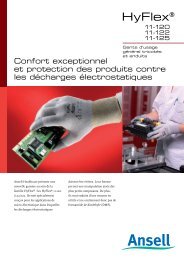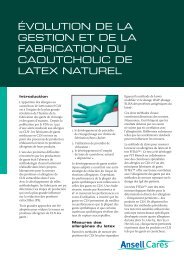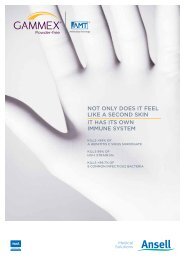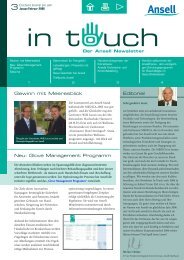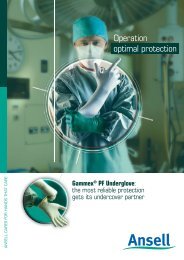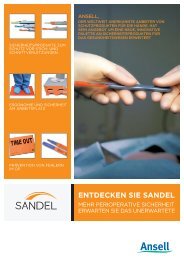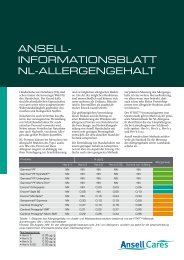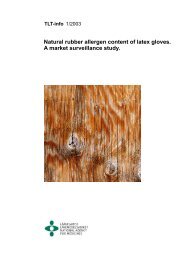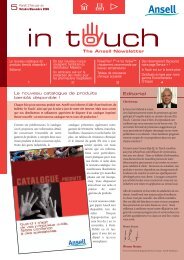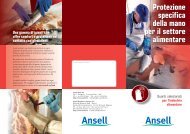Download full document - Ansell Healthcare Europe
Download full document - Ansell Healthcare Europe
Download full document - Ansell Healthcare Europe
You also want an ePaper? Increase the reach of your titles
YUMPU automatically turns print PDFs into web optimized ePapers that Google loves.
High temperature<br />
post washing versus<br />
DPNR latex<br />
High temperature washing of<br />
the latex film is very effective in<br />
reducing the overall protein allergen<br />
content of a latex film. Diagram 4<br />
schematically represents how High<br />
Ammonia (HA) NR and DPNR<br />
latices are coagulated to form films<br />
and then on-line leached.<br />
The high ammonia latex starts the<br />
process with a much higher level of<br />
extractable proteins (EP) than the<br />
enzyme treated DPNR latex. The online<br />
leaching process has a similar<br />
effect on both films, but as can be<br />
seen from the diagram the leaching<br />
only occurs from one side of the<br />
film.<br />
In Table 1 there is a comparison of<br />
the total allergen content of finished<br />
gloves made from standard HA<br />
latex and two types of commercially<br />
available deproteinized latices.<br />
The allergen content was measured<br />
using the FITkit TM . The results show<br />
The high temperature post washing<br />
is, however, better, because it is able<br />
to extract more of the EP as both<br />
sides of the film are exposed to the<br />
cleaning process. The hot water also<br />
hydrates the rubber film and<br />
������������<br />
����������<br />
�����������������<br />
�������<br />
�����������������<br />
���������������<br />
��������<br />
������������������<br />
������������<br />
�����������<br />
������������<br />
��������������<br />
����������������<br />
��������������<br />
�������<br />
Diagram 4<br />
Production process of DPNR latex<br />
Latex Type Glove Type High Temp<br />
Post<br />
Washing<br />
that although the DPNR latices<br />
produced films with low allergen<br />
content, the post processed gloves<br />
had values of more than 20 times<br />
lower.<br />
The preferred protocol for the High<br />
Temperature Post Washing was<br />
Hev b1<br />
ng/ml<br />
Hev b3<br />
ng/ml<br />
�����<br />
��������<br />
�������<br />
�������<br />
����������<br />
���������<br />
������<br />
�������<br />
�������<br />
������ ��<br />
�������� � �����<br />
������������<br />
������ �������<br />
�������� �<br />
������<br />
������ ��<br />
�������� � �����<br />
������������<br />
������ ���� ����<br />
���� �������<br />
���� ���� ����<br />
������� �������������<br />
������� �����<br />
���������� �������<br />
�������<br />
�����������<br />
�������<br />
Hev b5<br />
ng/ml<br />
as the film’s interstitial spaces are<br />
enlarged, the protein allergens are<br />
easily extracted. As a result, the final<br />
film formed by using standard HA<br />
latex has a lower protein allergen<br />
content than the film formed using<br />
the DPNR latex.<br />
������������<br />
������� ���� ����<br />
���� �������<br />
��������������<br />
������������<br />
�����������������<br />
�������<br />
�����������������<br />
���������������<br />
��������<br />
��������������<br />
����������������<br />
�����������������<br />
������������<br />
to initially wash the gloves in an<br />
industrial washer with hot water,<br />
temperature greater than 80 ̊C,<br />
containing a non-ionic surfactant for<br />
at least 20 minutes. The initial wash<br />
was then followed by two clean hot<br />
water, temperature greater than<br />
80 ̊C, rinse cycles.<br />
Hev<br />
b6.02<br />
ng/ml<br />
Sum of 4<br />
µg/g<br />
Total<br />
Allergens<br />
AU/ml<br />
High Ammonia Latex Powder-free Yes



